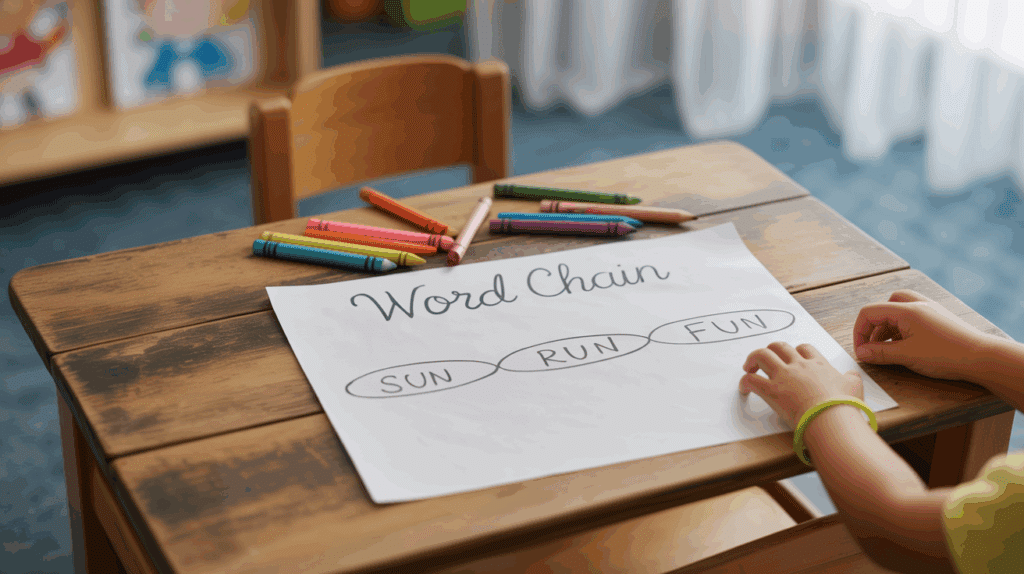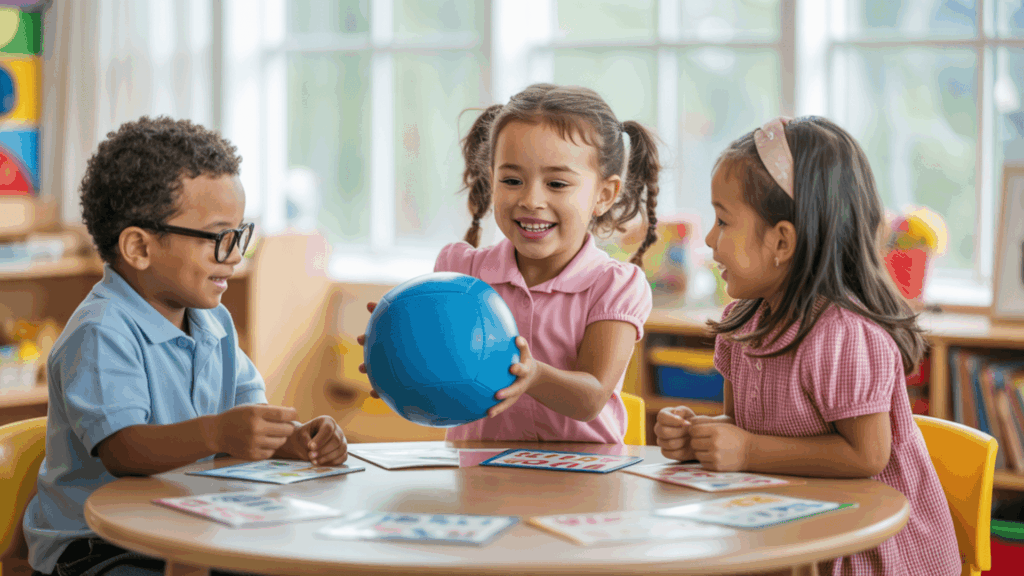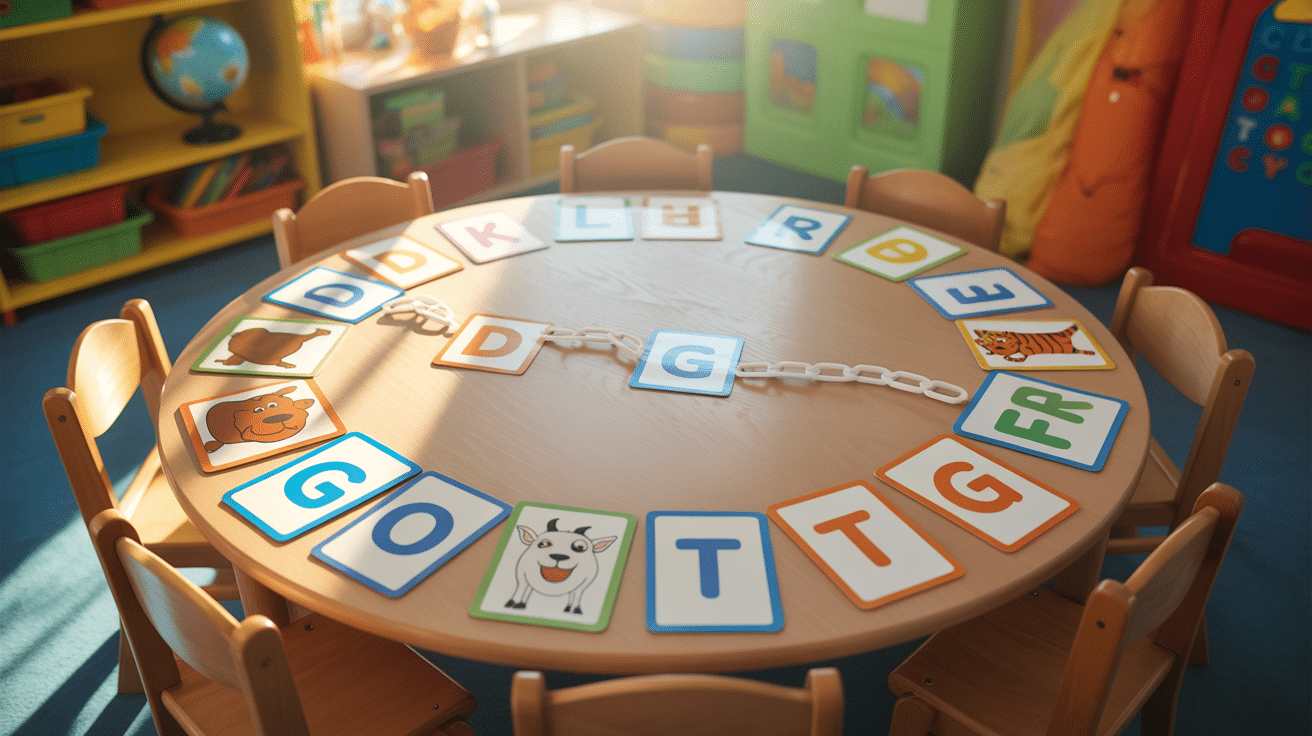Word chains hook kids on learning to read. Kids change just one letter at a time to make a new word. Cat becomes bat, then bit, then big.
This simple game builds key reading skills without feeling like work. Young readers learn to spot letter patterns and sound relationships while having fun.
The game can be played anywhere, at home, in the car, or while waiting in line.
No fancy tools needed, just quick thinking. Word chains turn spelling from boring to exciting, helping kids master words without even knowing they’re learning.
What are Word Chains?

Word chains create a fun way to build vocabulary skills. In this simple game, players take turns saying words where each new word must start with the last letter of the previous word.
For example, if the first player says “sun,” the next player might say “night” (since “sun” ends with “n”). Then the next word could be “tiger” (starting with “t”), followed by “rabbit” (starting with “r”).
The goal is to keep the chain going as long as possible without breaking the pattern or repeating words already used. This challenges players to think quickly and dig deep into their word banks. The game works well with all ages and can be adjusted for difficulty.
Younger players might use simple three-letter words, while older players can tackle longer, more complex vocabulary. The game requires no equipment, just minds ready to make connections.
Why the Word Chain Game Is Great for Learning
Word chains do more than just pass the time; they pack in serious learning benefits while kids have fun. This simple game helps build word knowledge, as players must recall words quickly and pay careful attention to spelling patterns.
Each turn reinforces letter recognition, as players must focus on the last letter of one word to find the first letter of the next. The best part? Kids don’t realize they’re practicing these important literacy skills; they’re just playing a game:
- Builds vocabulary banks: Players dig through their mental word collections, strengthening recall.
- Sharpens spelling awareness: Noticing letter patterns becomes automatic through repeated play.
- Encourages quick thinking: The pressure to respond keeps minds active and engaged.
- Develops active listening: Players must carefully hear the previous word to respond correctly.
- Creates low-pressure speaking practice: Even shy students participate willingly in a game format.
How to Play the Word Chain Game
Word chains provide simple fun that builds language skills naturally. Follow these steps to get started with this engaging vocabulary game in your classroom or home.
Step-by-Step Instructions
- Explain the Rules: Tell players each new word must begin with the last letter of the previous word. For example, “dog” would be followed by a word starting with “g” like “garden.”
- Start the Chain: Choose someone to say the first word to kick things off.
- Take Turns: Move around the group with each person adding a word that follows the pattern.
- Keep It Going: Continue until someone gets stuck or repeats a word already used.
Game Rules to Remember
- No repeats allowed – Once a word is used, it’s out of play for that round.
- Words must be real – No made-up words or inappropriate language.
- Consider a timer – Add excitement with a 5-10 second limit per turn.
Group Formats
- Whole-class circles work well for full participation.
- Small groups allow more turns per player.
- Pairs create quick back-and-forth practice.
Word Chains vs. Word Ladders: What’s the Real Difference
Word chains focus on changing one sound at a time to build phonemic awareness, while word ladders change one letter at a time to strengthen spelling and word recognition skills.
Both are valuable, but they target different aspects of early literacy.
| Feature | Word Chains | Word Ladders |
|---|---|---|
| Focus | Phonemes (individual sounds) | Letters (spelling changes) |
| Skill Targeted | Phonemic awareness and sound manipulation | Spelling patterns and word recognition |
| How it Changes | One sound change per word | One letter change per word |
| Example | cat → cut → cup → pup (each change affects a sound) | cat → cot → dot → dog (each step changes a letter) |
| Visual Component | Often oral/aural, may use counters or verbal prompts | Written or visual; typically done on paper or boards |
| Instructional Use | Great for early phonics, decoding, and dyslexia support | Good for spelling, vocabulary, and word structure awareness |
| Cognitive Emphasis | Auditory discrimination and phonological processing | Visual pattern recognition and memory |
| Common in | Phonics-based and structured literacy programs | Vocabulary enrichment and classroom word games |
Fun Variations of the Word Chain Game
Take your word chains to the next level with these creative twists! These variations keep the game fresh and target different learning styles while maintaining the core benefits of vocabulary building and quick thinking.
Themed Word Chains
Challenge players by limiting words to specific categories. Try animal chains (dog → giraffe → elephant), food words (apple → egg → grape), action words (jump → push → hop), or classroom items (pencil → lamp → paintbrush).
This builds vocabulary within useful categories and makes players think harder about their word choices.
Silent Word Chain
Transform the game into a writing activity by having students write their words instead of speaking them. Pass paper around a circle or use whiteboards to create the chain.
This variation helps reinforce spelling skills and works wonderfully for students who prefer writing to speaking aloud.
Speed Chain
Add excitement with a timer! Give each player just 5 seconds to come up with their word. This will increase the energy level and build quick-thinking skills.
For younger players, try 10 seconds, while older students might manage with just 3 seconds per turn.
Reverse Chain
Flip the pattern by requiring the next word to end with the first letter of the previous word. For example, after “cat,” the next word must end with “c” like “music.”
This increases difficulty and forces players to think about both ends of words.
Chain & Draw
Perfect for visual learners and younger students, this variation asks players to quickly sketch their word after saying it. This adds a creative element and helps cement word meanings through visual representation. Simple stick figures work fine!
Interesting Twists to Play Word Chain Games

Playing word chains doesn’t have to mean sitting still! These creative additions make the game more energetic and engaging for active learners.
Try these ideas to keep energy high while building vocabulary skills.
1. Toss and talk: After saying your word, pass a soft ball or bean bag to the next player. This adds physical movement and helps visual learners track whose turn comes next.
2. Stand-sit pattern – Have players stand when it’s their turn and sit after saying their word. This creates a visual rhythm and helps fidgety students channel energy.
3. Team challenges – Split into competing teams and keep score for the longest chains or the most creative words. Award bonus points for challenging words.
4. Add background beats – Play gentle music to set the pace of the game. Speed up or slow down the tempo for different skill levels.
5. Visual record – Create a paper chain on a bulletin board with each word written on a link, building a physical representation of your word connections.
The Bottom Line
Word chains change everyday language practice into an engaging game that builds critical skills without the tedium.
From classroom circles to family road trips, this versatile activity adapts to any setting while strengthening vocabulary, spelling awareness, and quick thinking.
By adding creative variations, such as themed categories or drawing elements, teachers and parents can keep the challenge fresh while targeting specific learning goals.
Next time vocabulary practice feels stale, try starting a chain and watch where the words lead.
What word chain variations have you tried with your students or children? Share your experiences or favorite themed categories in the comments below!




